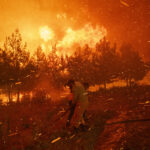During an upbeat earnings call focused on how RenaissanceRe is using $1 billion of capital it raised last year in 2021, the CEO highlighted one negative development for the industry overall — inadequate estimates of COVID-19 losses.
“Even as COVID 19 continues to spread, there has been some speculation that it will not prove as impactful for the insurance industry as originally foreseen. I do not believe this to be the case,” said Kevin O’Donnell, RenRe’s president and chief executive officer.
“In many instances, our industry has yet to recognize the losses that will inevitably arise from the pandemic, particularly with respect to business interruption. Likely, this lack of recognition occurred because it made renewals smoother at Jan 1,” O’Donnell continued.
“I believe that we still have a long way to go before the true scale of COVID-19 industry losses is fully apparent.”
O’Donnell made the remarks after describing a successful Jan. 1 season for his company, highlighted by better-than-expected reinsurance placements for U.S. casualty and E&S business, and after he projected full-year growth of $1 billion in net written premiums across both property and casualty segments for 2021 in total.
Last year, net written premiums rose just over $700 million, or 21% to $4.1 billion, while net income rose 2.7% to $731.5 million. Income for the year and the fourth-quarter rose in spite of weather-related large losses of $166.1 million for the quarter and $493.6 million for the year, and in spite of COVID-related losses of $172.7 million for the quarter and $286.6 million for the year.
Both O’Donnell and Chief Financial Officer Robert Qutub said that the fourth-quarter COVID figure is primarily IBNR and primarily related to business interruption coverage. They said that RenRe continues to estimate COVID losses in three categories, outlined last year:
- Category 1, which includes event-like losses closely linked to the virus, such as event contingency, event based casualty clash, and certain types of accident and health. (In first-quarter 2020, RenRe recorded $104 million in reserves, primarily for this category.)
- Category 2, which covers economic risks caused by recession impacts of COVID.
- Category 3, which relates to “known unknowns,” primarily business interruption.
Last year, O’Donnell explained the categorization of business interruption, saying that “the widely reported coverage of pandemic business interruption risk under property policies has been controversial” and that cedents were advising RenRe that they had minimal exposure and intended to fight any and all attempts by the plaintiffs’ bar to impose liability.
While O’Donnell repeated what he said last year on Wednesday’s fourth-quarter earnings call — that RenRe is continuing to monitor how the cases are playing out in courts — he added that the real answer is years away.
So far, he said, “The risk of widespread court leakage, where courts apply coverage where it is not expressly provided currently appears low” in the U.S.
Still, “while individual court rulings have been relatively favorable to the insurance industry, cases will take years to work through the system and some recent decisions have been adverse,” he noted.
Importantly, outside of the U.S., “in the UK, Europe and Australia, we have seen a trend of more affirmative contractual cover, and in situations of uncertainty, courts ruling in favor of the policyholder,” he said.
Qutub noted that the recent UK Supreme Court decision on the FCA non-damage business interruption case did not have material impact on RenRe’s loss fourth-quarter loss estimate.
During the Q&A part of the earnings call, analysts asked O’Donnell to clarify that he was more concerned about developments outside the U.S. related to the industry’s COVID losses, and also asked him to explain why the lack of recognition of COVID losses by the industry is more apparent now than it was last year.
Talking about the rigorous process that RenRe has undertaken to estimate its own exposure, he said the reinsurer continues to believe that it is less exposed relative to others in Category 3, in part, because half of the RenRe property-catastrophe book protects personal lines where it believe COVID exposure is lower.
“Internationally, we have seen more affirmative cover sold for business interruption related to communicable disease, and much of the reserve we put up in the quarter, although it’s in IBNR, would be in contemplation of some of the things we learned related to the international book that was renewing.”
He added: “The U.S. still remains uncertain. I think we’ll have a lot of ups and downs with court decisions as we go through this but we still remain relatively optimistic about courts being rational about their interpretation there.”
As for the increased evidence of affirmative cover being sold outside the U.S., O’Donnell said, “We are not surprised that this exposure existed.” As a result of discussions cedent-reinsurer discussions that took place during the 1/1 renewals, “it became more estimable,” he said, later revealing that RenRe’s estimation process involved cedent and reinsurer doing different analyses independent of each other to try to assess the information shared during 1/1 renewals.
“We had an actuarial approach, an underwriting approach and we worked with third-party advisors to reality-check it,” he said, describing the process as “strong and robust” but “not as clean as what you would have from an observable physical damage loss related to a hurricane or an event earthquake” due to the very uncertain nature of the risk.
Asked how RenRe got comfortable extending coverage even though cedents might not be on the same page with the reinsurer regarding the extent of the cedents’ COVID loss exposures, O’Donnell pointed to reworked contract language.
“It’s a delicate balance to think about how to have those conversations. It depends on what they know as well. The real issue is [for] the renewals that we had, we excluded COVID and addressed communicable disease specifically.”
“The [past] exposure is the exposure, and it will be sorted out over time. But going forward, the grant of coverage, if any was ever provided, is specifically and more precisely excluded in the contracts that we renewed.”
At one point during the call, O’Donnell described RenRe as a “market leader” in successfully “implementing communicable disease exclusions when necessary. And we demonstrated our resolve by nonrenewing several deals that did not incorporate the necessary exclusion,” he added.
Jan. 1 Recap
O’Donnell started the call with a short review of Jan. 1 activities, describing the date this year as “one of the most important renewals in our history,” and expressing pleasure over the fact that the company fully deployed a $1.1 billion capital raise from last June into its underwriting portfolio across property and casualty segments.
“In 2021, we expect to grow net written premiums by approximately $1 billion, and believe that we have materially increased the profitability of our underwriting book…while keeping our tail risk consistent with last year’s on a percentage of equity basis and….continuing to have ample dry powder to deploy into new opportunities,” he reported.
As he promised last year, O’Donnell said last June’s capital raise was used for two offensive purposes — to grow into an improving market and to retain more risk.
Commenting on the market improvement, O’Donnell said that RenRe’s expectations last year, and those of the reinsurance industry, pointed to the property-cat and retro markets as the most promising 1/1 market opportunities. But dynamics shifted late in the renewal period — after mid-December — as less demand and more supply began to emerge.
“In part, I think this was because [insurers’] investment portfolios were disconnected from the financial reality of COVID-19 and the economic recession. The resulting boost to book values decreased relative reinsurance demand by giving many [cedents] the confidence to retain more risk,” he said, noting that new capital also entered the retro and property-cat markets on the supply side.
“Throughout the renewal, however, both casualty and specialty lines, as well as property E&S continued to experience extremely favorable pricing dynamics. In general, both outperformed our expectations — with increased rates as well as improved terms and conditions,” he said.
Providing some numbers to contrast the magnitude of price changes in various areas of the RenRe book, O’Donnell reported that:
- Rates were up 20-25% on targeted cat-exposed property risks in the U.S. E&S market, while traditional property-cat was more muted — with flattening demand and rate hikes averaging about 10%.
- Retro rates were up 5-15%, as additional supply began suppressing rate increases as renewal progressed. Still, four consecutive years of rate hikes add up to cumulative average rate increases approaching 50%.
While not providing those kind of specifics for casualty and specialty business, O’Donnell said that market dislocations in various classes are opening up opportunities for RenRe to write roughly $500 million of gross premiums in 2021, with lines like GL and D&O being particularly attractive.
Changing Climate
O’Donnell also provided some commentary on the impact of a warming climate on natural catastrophe losses that the industry responded, including 30 named storms and five of the six largest California wildfires in history (measured by acreage burned).
“We expect that the climate will make extreme events more frequent and more severe, however, this does not mean we expect every year to be like 2020,” he said. “What has increased is the likelihood of extreme events relative the long-term record.”
“The insurance industry has always used the past to predict the future. But now the future no longer resembles the past. Our ability to understand this shift in future risk provides us with a competitive advantage, allowing us to position ourselves for a changing climate,” he said.
Earlier this month, RenRe unveiled the mission of “promoting climate resilience” as part of its Environmental, Social and Governance (ESG) strategy.
This article first was published in Insurance Journal’s sister publication, Carrier Management.
Topics Profit Loss
Was this article valuable?
Here are more articles you may enjoy.



 Aon Extends Employment Agreement With CEO Case
Aon Extends Employment Agreement With CEO Case  ’60 Minutes’ Homeowners Ask Court to Force DFS to Divulge Heritage Probe Info
’60 Minutes’ Homeowners Ask Court to Force DFS to Divulge Heritage Probe Info  Howden Buys M&A Insurance Broker Atlantic Group in US Expansion
Howden Buys M&A Insurance Broker Atlantic Group in US Expansion  2025 Was One of Three Hottest Years on Record: Researchers
2025 Was One of Three Hottest Years on Record: Researchers 


